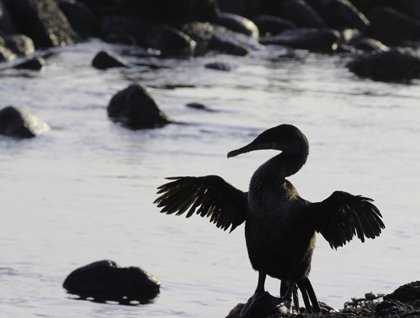Many of us woke up early this morning to try to find some marine life from the sundeck while we circumnavigated the northern side of Isabela (the sea horse shaped Island). The titans, known as Ecuador and Wolf volcanoes, looked spectacular with colorful lava fields decorated with a yellowish color, harmonizing with the sky on this beautiful morning. After breakfast the ship crossed the equator line, so we celebrated with a special ceremony. As soon we dropped anchor at Punta Vicente Roca we headed out on a Zodiac ride along the coast of Isabela to observe several geological features which are evidence of previous eruptions which occurred long ago. We saw long lines of black lava and blue footed boobies and frigate birds who were looking for food. The sun appeared and warmed up this location and marine iguanas did not lose time to start swimming and trying to eat some seaweed. They were accompanied by some Galapagos penguins which swam as fast as torpedoes and fed on small black striped Salemas. We also spotted flightless Cormorants feeding underwater. We headed back to the National Geographic Islander so our guests could get ready for the snorkeling activity. Our explorers found different species of fish, but probably the most interesting and abundant creatures of all were the green turtles. Of course, Galapagos penguins and flightless cormorants delighted our guests who enjoyed swimming with incredible creatures like nowhere else in the world.
We disembarked and finally arrived to the black lava field where hundreds of marine iguanas were warming up under the sun and getting close together to retain their body heat. We also found sea lions, some flightless cormorants, and one Galapagos hawk watching everything from the top of a mangrove tree. The lava fields were spectacular and allowed us to feel as if we traveled back in time to enjoy the Galapagos without any human impact and with pristine environments.







